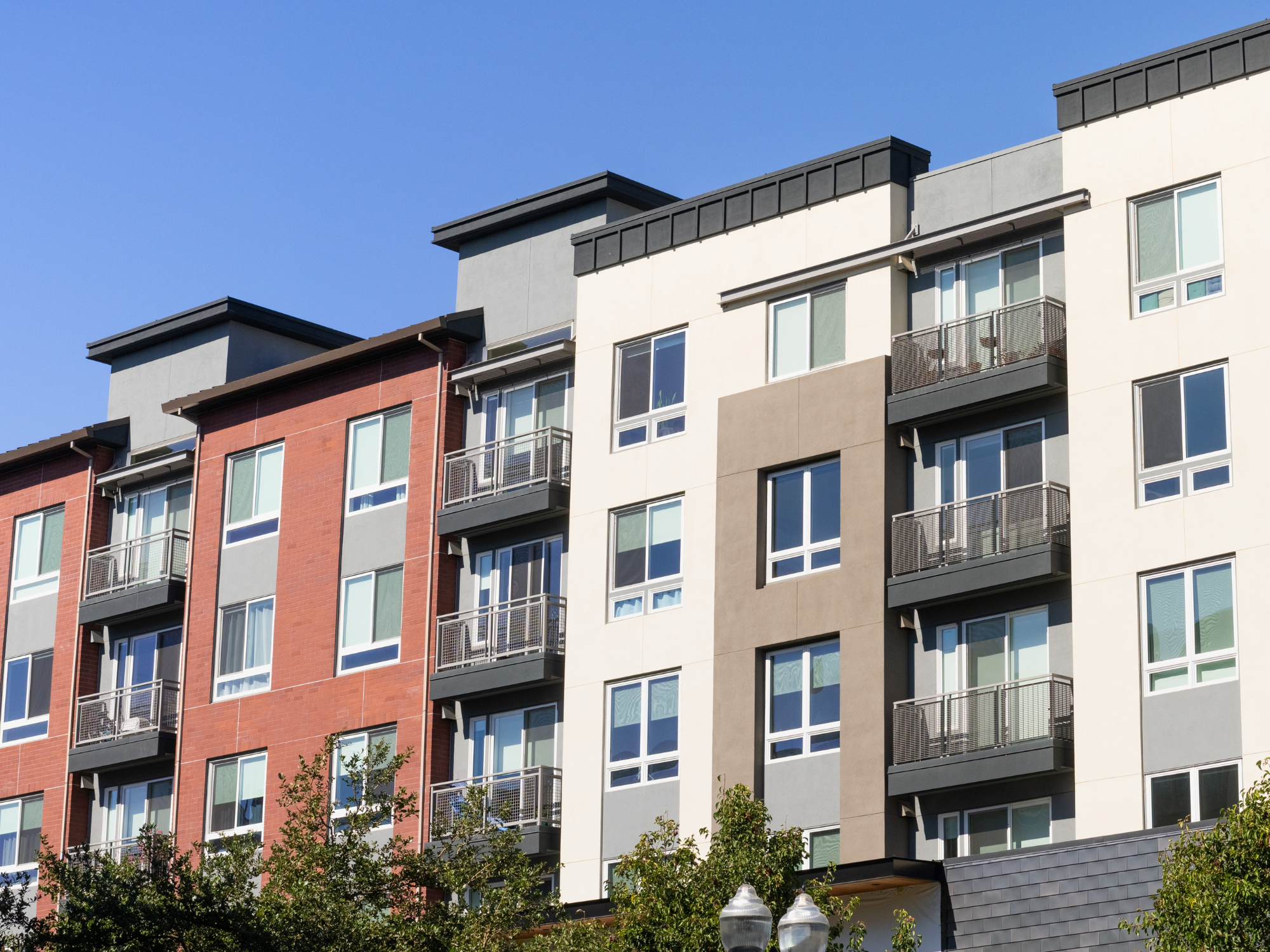

Blog
LEED v5 is here! And with it are exciting changes to most prerequisites and credits in the LEED rating systems. Here, we’re focusing on the exciting updates to building decarbonization.

After two public comment periods and a member ratification vote, the U.S. Green Building Council (USGBC) launched the long-awaited LEED v5 in April 2025, the biggest wholesale update since LEED v4.1 was rolled out in 2019.
The updated program organizes its mandatory prerequisites and point-weighted credits around three impact areas: decarbonization, quality of life, and ecological conservation and restoration.
In this blog post, we’re focusing on the decarbonization impact area, which USGBC describes as “reductions in operational, embodied, refrigerants, and transportation emissions.” It’s truly a holistic approach in which all of the major sources of carbon emissions from buildings are taken into account, with an emphasis on decarbonizing operational emissions through electrification and reducing the carbon impact of materials during construction.
Read on to learn about the changes to operational and embodied carbon requirements in LEED v5 for Building Design and Construction (BD+C): New Construction.
Contact SWA to get started on your LEED v5 project.
USGBC recognizes that every new building becomes an existing building, and the LEED program has evolved to add emphasis on anticipated operational carbon emissions, aligning more closely with jurisdictions that have begun implementing carbon and energy efficiency standards for existing buildings.
Leaders in our industry have moved toward measuring the success of reducing a building’s impact on the climate through the adoption of mandates such as NYC’s Local Law 97 (LL97), DC’s Building Energy Performance Standards (BEPS), and Boston’s Building Emissions Reduction and Disclosure Ordinance (BERDO).
LEED BD+C has long been perceived as a prescriptive approach to designing and constructing a better building. However, there has often been a gap between the designed performance and true operational performance of a building. But that’s changing.
Now let’s dive deeper into some of these new prerequisites and credits focused on decarbonizing our buildings.
One of the newest prerequisites to the Integrative Process category involves almost no additional work for LEED project teams.
USGBC will take the data from several other LEED prerequisites and develop a 25-year projection of the project’s emissions from building operations, refrigerant use, and embodied carbon. Projects will have the option to include emissions associated with transportation as well if they pursue the Transportation Demand Management credit (LTc4).
This new assessment will allow project teams to better understand the basic carbon impacts of their project without the need for additional time or cost to conduct a detailed analysis.
Projects located in jurisdictions with operational carbon or efficiency mandates may wish to conduct more detailed whole building carbon assessments early in design to future-proof against potential penalties.
The Operational Carbon Projection and Decarbonization Plan requirement is a new prerequisite in LEED v5 that requires project teams to perform a design analysis, establish a site energy estimate, review a carbon projection, and create a decarbonization plan.
While this may seem like a lot of requirements for a new prerequisite, most of our project teams are already performing similar studies to better understand projected energy use. We’ll break down the requirements individually:
This requirement is similar to the simple box energy modeling effort within the LEED v4 Integrative Process credit, where project teams analyze opportunities for load reductions. Here, teams must identify energy reduction and decarbonization measures early in design. It’s critical to identify energy and carbon saving measures early in the design process to ensure the building is optimized to maximize efficiency and reduce both operational and embodied carbon.
This is not a new requirement, as LEED projects have always been required to perform an energy model and identify energy use by type. This requirement will now be used to help generate a carbon projection for the building.
USGBC will generate a business as usual (BAU) projection for carbon emissions using the annual energy use data submitted as part of the Minimum Energy Efficiency prerequisite.
Projects located in jurisdictions with carbon-based Building Performance Standards, such as NYC’s Local Law 97, must create a BAU based on the requirements of their specific standard. The projection must include an analysis of potential annual fines associated with the design compared to the local ordinance.
Finally, all projects are required to demonstrate either that they are fully electric or that they have a plan in place to decarbonize the building over the next 25 years.
The simplest path to decarbonization is utilizing fully electric systems (no gas or fuel systems for HVAC or water heating). This is also the only way projects can now achieve LEED Platinum certification.
This new LEED v5 credit increases the incentive to fully electrify. Projects that fully electrify get full credit with 5 points (excluding back-up power systems).
Additional options are provided to projects seeking to improve their lower-carbon performance but can’t fully electrify. This gives flexibility to project teams that can’t fully electrify due to low temperatures, service or domestic hot water, or some cooking and process loads.
Many of our clients are already fully electrifying. NYC, DC, Boston, and other major metro areas have gas prohibition requirements or carbon emissions cap laws. This credit will further improve building performance with respect to these laws and will prepare buildings for compliance.
Embodied carbon is the next frontier in truly reducing all carbon emissions related to the construction of a building. LEED v5 mandates all project teams to quantify the embodied carbon impacts (via global warming potential or GWP) of the structure, enclosure, and hardscape materials. At a minimum, this should include asphalt, concrete, masonry, structural steel, insulation, aluminum extrusions, structural wood and composites, cladding, and glass.
Projects must also quantify the cradle-to-gate (A1 through A3) embodied carbon emissions for each material, defined as the product’s GWP/unit times the amount of material used.
Get more details on what the new embodied carbon requirements mean for your projects.
Our industry has entered an era where we have the tools to measure and address carbon emissions across the whole lifecycle of a building. But perfection cannot be the enemy of progress. Every project presents different challenges, and we must look for opportunities to reduce both embodied and operational carbon emissions in every new building.
The new decarbonization requirements in LEED v5 provide a workable framework for decarbonization for all scopes of emissions. The emphasis on quantifying, assessing, and planning for low-carbon buildings, rather than just energy cost savings, gives the industry actionable steps to see where the biggest impact can be made to combat climate change.
USGBC uses the phrase “near-zero carbon reality” in describing the design of the LEED v5 program. Let’s get as close to zero as we can.
SWA has been working with LEED since its inception—our founder Steven Winter helped launch the program during his tenure as chairperson of USGBC from 1999-2003.
Our approach to LEED certification is rooted in research and real-world experience. SWA consultants are continuously learning so we can create better buildings for our partners, people, and the planet.
SWA supports existing buildings and new construction, and we have access to large amounts of data from sustainable buildings that are fully operational. This feedback loop gives us a rare look at what works (and what doesn’t) in high-performance, low-carbon buildings.
Our team will help develop targeted strategies for short-term and long-term carbon reduction investments, including assembling project teams and determining the true energy, carbon, and economic savings for each measure. SWA’s experienced engineers will help with every step of developing your project’s decarbonization and efficiency plans.
We also address embodied carbon through Hot Spot Assessments (prerequisite) and Whole-Building Life Cycle Assessments (credit) and look for opportunities to incorporate low-carbon materials.
Contact us to get started on your LEED v5 project.
Learn more about our building certification services.
Contributors: Sean Fish, Sustainability Director; Sarah Nugent, Sustainability Director
Steven Winter Associates